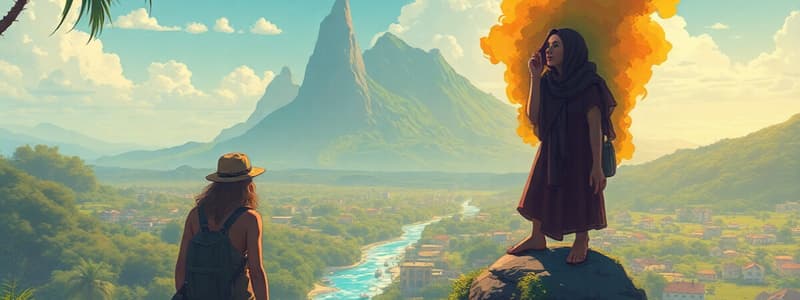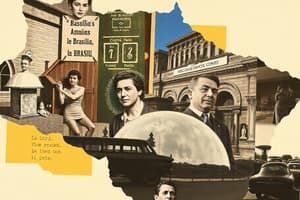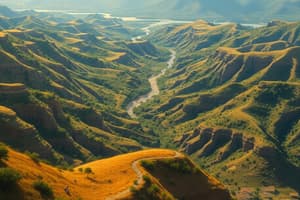Podcast
Questions and Answers
Brazil is the second-largest country in South America.
Brazil is the second-largest country in South America.
False (B)
The population of Brasilia, the capital of Brazil, is approximately 4.2 million.
The population of Brasilia, the capital of Brazil, is approximately 4.2 million.
True (A)
The Brazilian population is roughly two-thirds the size of the population of China.
The Brazilian population is roughly two-thirds the size of the population of China.
False (B)
The majority of the Brazilian population identifies as Roman Catholic.
The majority of the Brazilian population identifies as Roman Catholic.
The Amazon Basin drainage system is exclusively located within Brazil.
The Amazon Basin drainage system is exclusively located within Brazil.
The Amazon Basin was among the first areas in the Americas to be populated by Europeans.
The Amazon Basin was among the first areas in the Americas to be populated by Europeans.
The Gran Chaco is primarily divided between Argentina, Chile, and Paraguay.
The Gran Chaco is primarily divided between Argentina, Chile, and Paraguay.
The Chaco War in the 1930s was fought between Bolivia and Argentina.
The Chaco War in the 1930s was fought between Bolivia and Argentina.
Mennonites who settled in Gran Chaco in the 1920s were primarily from Canada and the USA.
Mennonites who settled in Gran Chaco in the 1920s were primarily from Canada and the USA.
Landforms are natural features of the earth's surface, including features like deserts, plains, and plateaus.
Landforms are natural features of the earth's surface, including features like deserts, plains, and plateaus.
The tallest mountains in political Europe are Mount Elbrus in Turkey and Mont Blanc in the Alps.
The tallest mountains in political Europe are Mount Elbrus in Turkey and Mont Blanc in the Alps.
The longest river in Europe is the Blue Danube, with a total length of 1,780 miles.
The longest river in Europe is the Blue Danube, with a total length of 1,780 miles.
Europe's definition is consistent and clearly defined across political, geographical, and cultural contexts.
Europe's definition is consistent and clearly defined across political, geographical, and cultural contexts.
The European Union aims to restrict the movement of people, capital, goods, and services between member countries.
The European Union aims to restrict the movement of people, capital, goods, and services between member countries.
Wars and their aftermaths have significantly shaped the borders of countries in Europe, even to this day.
Wars and their aftermaths have significantly shaped the borders of countries in Europe, even to this day.
Flashcards
Brasilia
Brasilia
The capital of Brazil, with a population of around 4.2 million, known for its diverse caves and the world's largest flying flags.
Brazil
Brazil
The largest country in South America and the fifth largest in the world.
The Gran Chaco
The Gran Chaco
A vast lowland region in South America, encompassing parts of Argentina, Bolivia, Paraguay, and Brazil, characterized by its arid to semi-arid climate.
The Amazon Basin
The Amazon Basin
Signup and view all the flashcards
Amerindians
Amerindians
Signup and view all the flashcards
The Brazilian Population
The Brazilian Population
Signup and view all the flashcards
Colonization of Amerindians
Colonization of Amerindians
Signup and view all the flashcards
The Chaco War
The Chaco War
Signup and view all the flashcards
What is a landform?
What is a landform?
Signup and view all the flashcards
What is the Alps?
What is the Alps?
Signup and view all the flashcards
What is the European Union (EU)?
What is the European Union (EU)?
Signup and view all the flashcards
What is a border?
What is a border?
Signup and view all the flashcards
How are borders created?
How are borders created?
Signup and view all the flashcards
What is a natural barrier?
What is a natural barrier?
Signup and view all the flashcards
Why do European countries share borders?
Why do European countries share borders?
Signup and view all the flashcards
Study Notes
Brazil
- Brazil is the largest country in South America and the fifth-largest globally.
- Brasilia, the capital, has a population of 4.2 million.
- Located Southeast of the country's center
- Known for extensive cave systems, new business ventures, and a large national flag.
- Population: 212.6 million (about two-thirds of the US population).
- Diverse ethnic, geographic, and religious backgrounds; majority Roman Catholic.
- Government structure: Executive, Legislative, and Judiciary branches.
- Amerindians (Native Brazilians) faced colonization before regaining power.
- Popular tourist destination and World Cup winner.
Amazon Basin
- The Amazon Basin is the drainage system of the Amazon River in South America.
- Covers parts of Brazil, Peru, Bolivia, Colombia, Venezuela, Ecuador, Guyana, and Suriname.
- Sparsely populated.
- Home to diverse Amerindian nations for millennia.
- One of the last parts of the Americas settled by Europeans.
- Faces political challenges balancing resource extraction, environmental protection, and representation of remote inhabitants, including Amerindian tribes with varying levels of contact with Euro-American societies.
Gran Chaco
- Arid to semi-arid lowland region shared by Argentina, Bolivia, Paraguay, and a small part of Brazil.
- Initially inhabited by sparse hunter-gatherer societies.
- Ignored by Spain until after the independencies of surrounding nations.
- Argentina and Bolivia resolved border disputes in the 1870s.
- Bolivia and Paraguay fought the Chaco War in the 1930s over rumored oilfields.
- Mennonites from Canada and the USSR settled in the 1920s, maintaining their traditions.
- Slow technological development; first paved highways built in the 1960s.
- Cattle ranching remains the dominant industry.
European Landforms
- A landform is any natural feature of the earth's surface, including mountains, valleys, canyons, lakes, rivers, coasts, and bays.
- Alps: Europe's largest mountain range.
- Highest mountains in political Europe are: Mount Ararat (Turkey, 16,854 ft) and Mont Blanc (Alps, 15,782 ft).
- Highest mountain in geographical Europe: Mount Elbrus (Russia, 18,510 ft).
- Famous valleys: Loire and Rhône (France), Danube (Germany).
- Europe's largest canyon: Tara River Canyon (Montenegro, 4,265 ft).
- Europe's longest river: Danube (1,780 miles).
- Important rivers: Elbe (Germany, Czech Republic) connecting important cities. Loire, Rhine (France).
- Europe's largest lake: Lake Vanern (Sweden, 5,655 sq km), but far surpassed by Lake Ladoga (Russia, 17,700 sq km).
Europe: Boundaries and Divisions
- Europe's definition is complex (continent, plate, countries that consider themselves European, EU, etc.)
- Europe is characterized by 50 countries; 28 are members of the European Union (EU).
- EU: political and economic union promoting free trade and cooperation.
- EU Parliament: elected by EU citizens every five years.
- Free movement of people, capital, goods, and services among member countries.
- EU's formation was gradual after World War II.
- Borders have cultural significance (identity, ethnicity, history, language).
- Land has economic value (resources).
- Wars over land and resources are frequent in history.
- Cold War's Iron Curtain divided Western Europe from Eastern Europe.
- Powerful European countries (UK, France, Spain) had empires and competed globally, leading to conflicts.
- Wars shaped European borders, including the aftermath of WWI and the breakup of the Ottoman and Hungarian empires.
- Physical barriers (rivers, mountains) often created borders.
Studying That Suits You
Use AI to generate personalized quizzes and flashcards to suit your learning preferences.




